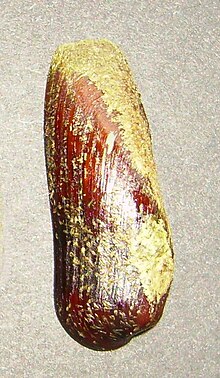Lithophaga
Appearance
| Lithophaga Temporal range: Triassic to Recent
| |
|---|---|

| |
| One valve of a shell of Lithophaga truncata | |
| Scientific classification | |
| Kingdom: | |
| Phylum: | |
| Class: | |
| Subclass: | |
| Order: | |
| Family: | |
| Genus: | Lithophaga Röding, 1798
|
| Species | |
|
See text | |
| Synonyms[1] | |
| |
Lithophaga, the date mussels, are a genus of medium-sized marine bivalve molluscs in the family Mytilidae. Some of the earliest fossil Lithophaga shells have been found in Mesozoic rocks from the Alps and from Vancouver Island,[2] [3]
The shells of species in this genus are long and narrow with parallel sides. The animals bore into stone or coral rock with the help of pallial gland secretions,[4] hence the systematic name Lithophaga, which means "stone-eater". Their club-shaped borings are given the trace fossil name Gastrochaenolites.[3]
Species
Species within the genus Lithophaga include:
- Lithophaga antillarum (d'Orbigny, 1842) - giant date mussel
- Lithophaga aristata (Dillwyn, 1817) - scissor date mussel
- Lithophaga attenuata (Deshayes, 1836) - attenuated date mussel
- Lithophaga balanas Dall
- Lithophaga balanus Dall
- Lithophaga bisulcata (d'Orbigny, 1842) - mahogany date mussel
- Lithophaga cardigera
- Lithophaga cavernosa
- Lithophaga cinnamomeus
- Lithophaga dactylus
- Lithophaga fasciola Dall, Bartsch, & Rehder
- Lithophaga gracilis Philippi
- Lithophaga hawaia Dall, Bartsch, & Rehder
- Lithophaga ilabis (Deshayes)
- Lithophaga lithophaga (Linne)
- Lithophaga nigra (d'Orbigny, 1842) - black date mussel
- Lithophaga plumula (Hanley, 1844) - feather date mussel
- Lithophaga punctata (Kleemann & Hoeksema, 2002)
- Lithophaga rogersi S. S. Berry, 1957 - Roger's date mussel
- Lithophaga truncata (Gray, 1843)
- Lithophaga simplex
References
- ^ Gofas, Serge (2004). "Lithophaga Röding, 1798". WoRMS. World Register of Marine Species.
- ^ Ludvigsen, Rolf & Beard, Graham. 1997. West Coast Fossils: A Guide to the Ancient Life of Vancouver Island. pg. 102
- ^ a b Kleemann, K.H., 1994. Mytilid bivalve Lithophaga in Upper Triassic coral Pamiroseris from Zlambach Beds compared with Cretaceous Lithophaga alpina. Facies 30, 151-154.
- ^ "integument (mollusks)."Encyclopædia Britannica. 2009. Encyclopædia Britannica 2006 Ultimate Reference Suite DVD
Wikispecies has information related to Lithophaga.
